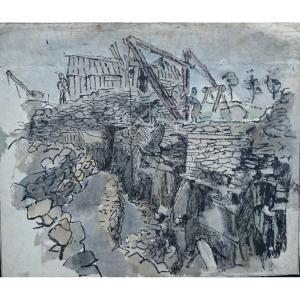In the space of a single sheet the story of Ulysses and Circe is told to us. Having landed on the island of Aea, the famous Greek hero sends his captain Eurylochus and some companions to reconnoitre. Seeing a magnificent palace on their way, they decide to enter it, with the exception of their captain who remains suspicious. Circe, mistress of the place, welcomes them by offering them a rich banquet. The sailors accept with joy but as soon as the meal is swallowed, their host transforms them into animals with a simple wave of a wand. So we see them here drawn as men with the heads of a deer, a bull or a lion, while one last unfortunate person is about to be also metamorphosed! Having witnessed this act of witchcraft, Euryloque goes to warn Ulysses who remains on the boat to the left of the composition. Driven by the desire to save his men, the king of Ithaca is however helpless in the face of this magic. Hermes, descending from the sky towards the trireme, will however intercede on her behalf by entrusting her with a secret plant which will allow her to counteract the effects of the witch's evil brew. Now immune, the Homeric hero will manage to free his companions and will end up marrying Circe.
Our drawing shows (bottom right) a collector's mark identified at Lugt under the number L.712.
While the limits of the natural sciences were still vague, scholars of the Modern Era were passionate about the occult sciences, like alchemy which was practiced until the 18th century. In this light, the witches' sabbaths and other alchemists' cabinets painted by northern artists reflect this interest in occultism. Better suited to the southern sensibility of our artist, the legend of Ulysses and Circe offers him the opportunity to multiply esoteric symbols such as this book open to obscure symbols, these transformed men or this mirror with hallucinatory reflection. Through a lively but precise pen drawing, he delivers a complete story in a restricted format. Although numerous, the details do not appear overabundant thanks to the division of the composition according to shades of wash. Thus, Hermes and Ulysses interact in a clear distance while a more intense gray is used to draw attention to the metamorphoses in the foreground. Although little represented in the history of art, this theme caught the attention of artists who stayed in Rome such as Antonio Tempesta, who engraved it in 1606, or Stradanus, who drew it in 1577. Baroque composition of this drawing combined with the theatricality of the figures allows us to place our artist within the Roman school of the early 17th century.
Our drawing is presented under a mat and anti-reflective glass in a frame with Bérain style decoration.
Dimensions: 13.5 x 19.5 cm – 32.5 x 38.5 cm with frame.
Bibliography:
- GRIMAL, Pierre, Dictionary of Greek and Roman Mythology, Paris, PUF, 1999.
- PETRIOLI TOFANI, Annamaria, Drawing: forms, techniques, meanings, Instituto Bancario San Paolo Di Torino, 1979.
- ROSENBERG Pierre, Drawings from the collection Mariette, Italian and Spanish schools, Paris, Somogy Editions, 2019.
- SCIOLLA, Gianni Carlo, Drawing: Italian public collections, Istituto Bancario San Paolo di Torino, 1994.

























 Le Magazine de PROANTIC
Le Magazine de PROANTIC TRÉSORS Magazine
TRÉSORS Magazine Rivista Artiquariato
Rivista Artiquariato
